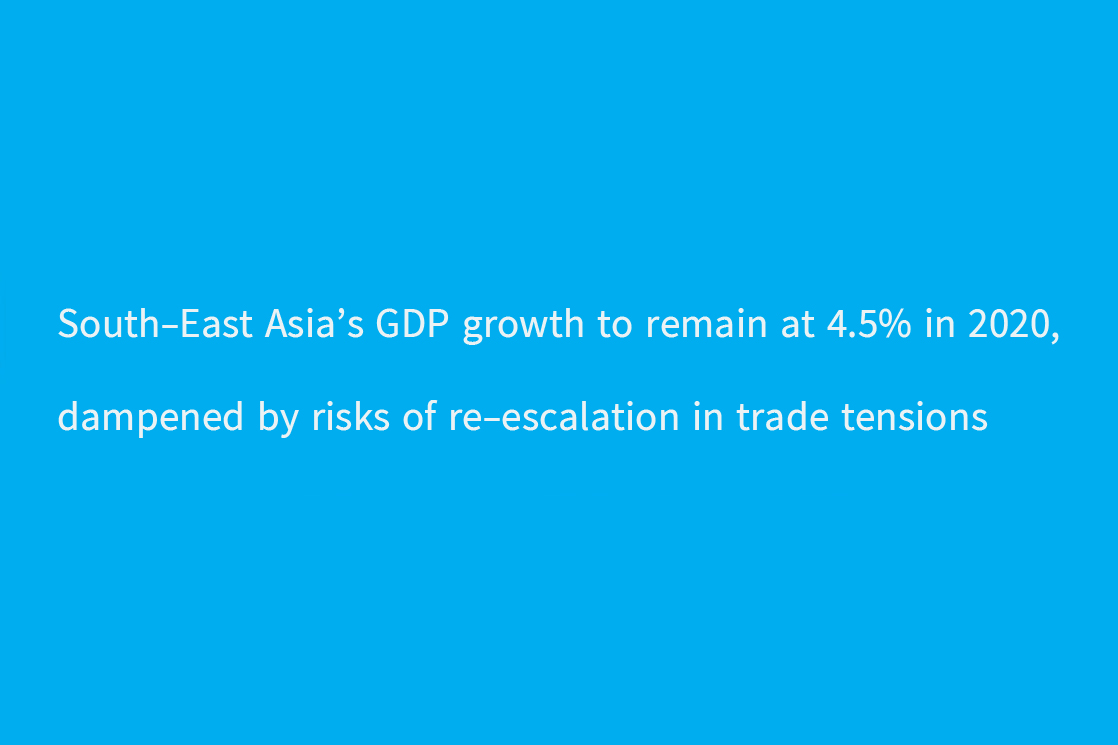Economic growth across the South-East Asia (SEA) region, including Myanmar, is expected to slow from 5.1% in 2018 to 4.5% in 2019 and remain unchanged in 2020, amid high risks of a re-escalation in trade tensions, according to ICAEW’s latest Economic Insight: South-East Asia reporton 11 December, 2019. As a result, the outlook for exports and private investment will remain challenging and continue to dampen regional GDP growth.
Regional growth has slowed since 2018 and remained sluggish in Q3 2019, with GDP growth across the SEA region rising only 4.5% year-on-year from 4.4% in Q2 2019. Even though the World Bank reported recently that the Myanmar economy is projected to grow by 6.6% percent in 2020, with the US-China trade conflict has been a key driver for this continuous slowdown in growth, with trade uncertainty remaining a key drag on manufacturing, exports and investment.
Export-oriented economies have been the most impacted by the ongoing trade tensions, with Singapore only narrowly avoiding a technical recession1 in Q3 2019.
The exception has been Viet Nam, which has benefited from some trade diversion effects caused by the trade war. Nonetheless, momentum in Viet Nam is expected to ease to 6.6% in 2020, from 7% in 2019, given weaker Chinese import demand and increased trade protectionism.
Sian Fenner, ICAEW Economic Advisor and Oxford Economics Lead Asia Economist said, “Although there has been some progress in the talks between the US and China, friction between the two countries remains high and the bulk of imposed tariffs are unlikely to be lifted anytime soon.
Alongside slower Chinese domestic demand, we are cautious that the outlook for regional exports and private investment will remain challenging. As such, we expect South-East Asia’s GDP growth to moderate to 4.5% in 2020, remaining unchanged from 2019.”
Increased fiscal stimulus to complement accommodative monetary policy
Alongside a more dovish US Federal Reserve, low inflation and a deteriorating economic outlook, regional central banks have shifted to a more accommodative stance.
The Philippines, Malaysia and Indonesia are expected to reduce interest rates by a further 25 basis points (bp) over the coming quarters, followed by an extended pause with fiscal stimulus to complement central bank efforts in cushioning the economic slowdown.
However, the room for fiscal manoeuvring will differ across the region. Most South-East Asian economies such as Thailand and the Philippines are expected to roll out stronger fiscal impulses. After running a series of fiscal surpluses, Singapore has the most fiscal room to ease policy.
Given the highly uncertain trade environment, Singapore’s government is likely.
to announce measures such as cash handouts and funding support for Small and Medium Enterprises (SME) in next year’s budget.
In contrast, both Viet Nam and Malaysia are constrained, given current levels of public debt.
In Malaysia, despite the announcement of a mildly expansionary budget for 2020, the government’s continued emphasis on fiscal consolidation and the risks of fiscal slippage suggest limited room for further support.
“We expect the ongoing trade tensions to continue weighing on the overall growth outlook for South-East Asian economies.
Against a weak global backdrop, supportive fiscal measures are expected to underpin an improvement in GDP growth across certain economies, albeit moderately. Overall, South-East Asia’s GDP growth in 2019 and 2020 are still set to be below potential at 4.5%,” said Mark Billington, ICAEW Regional Director, Greater China and South- East Asia. — ICAEW



